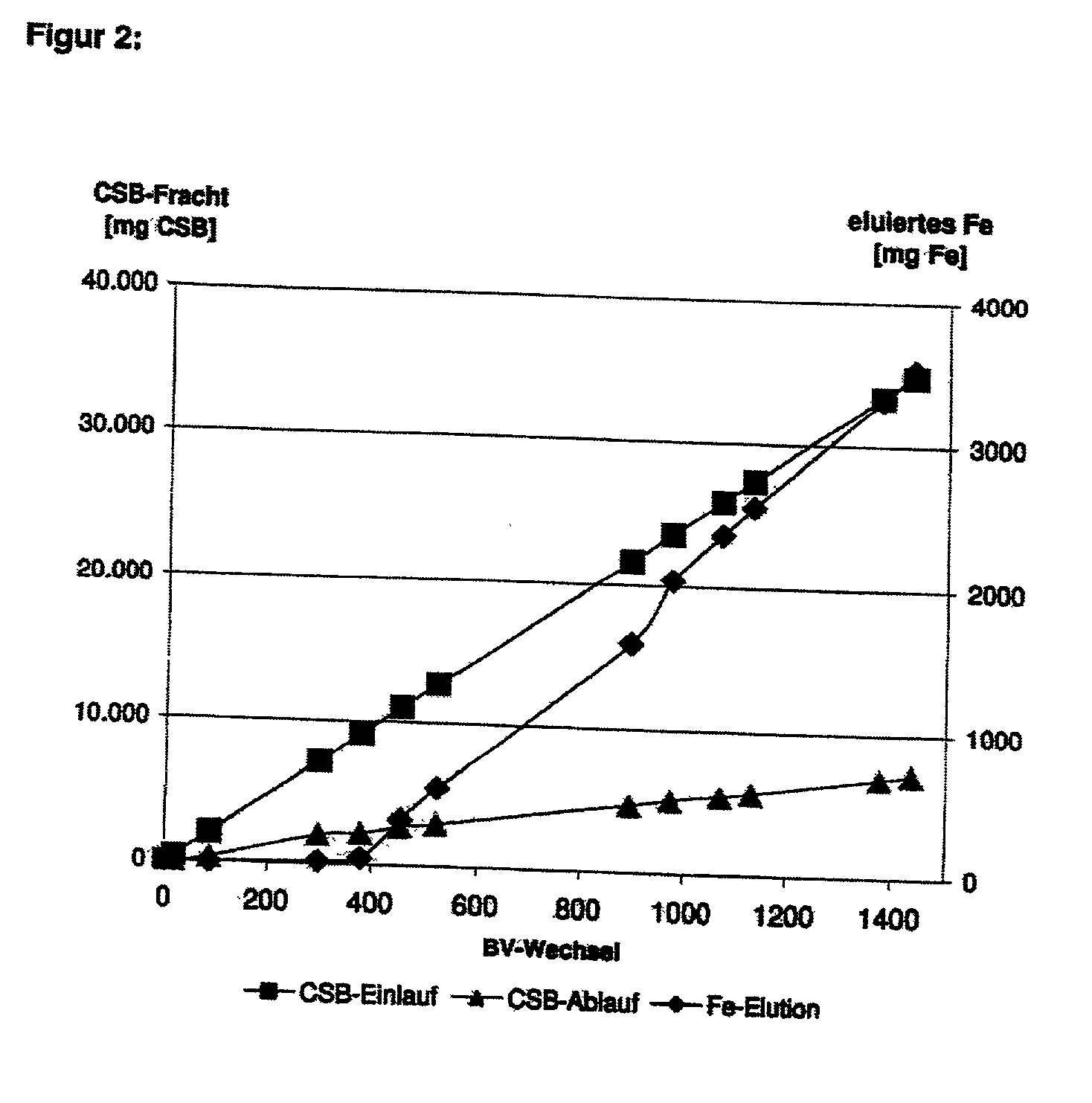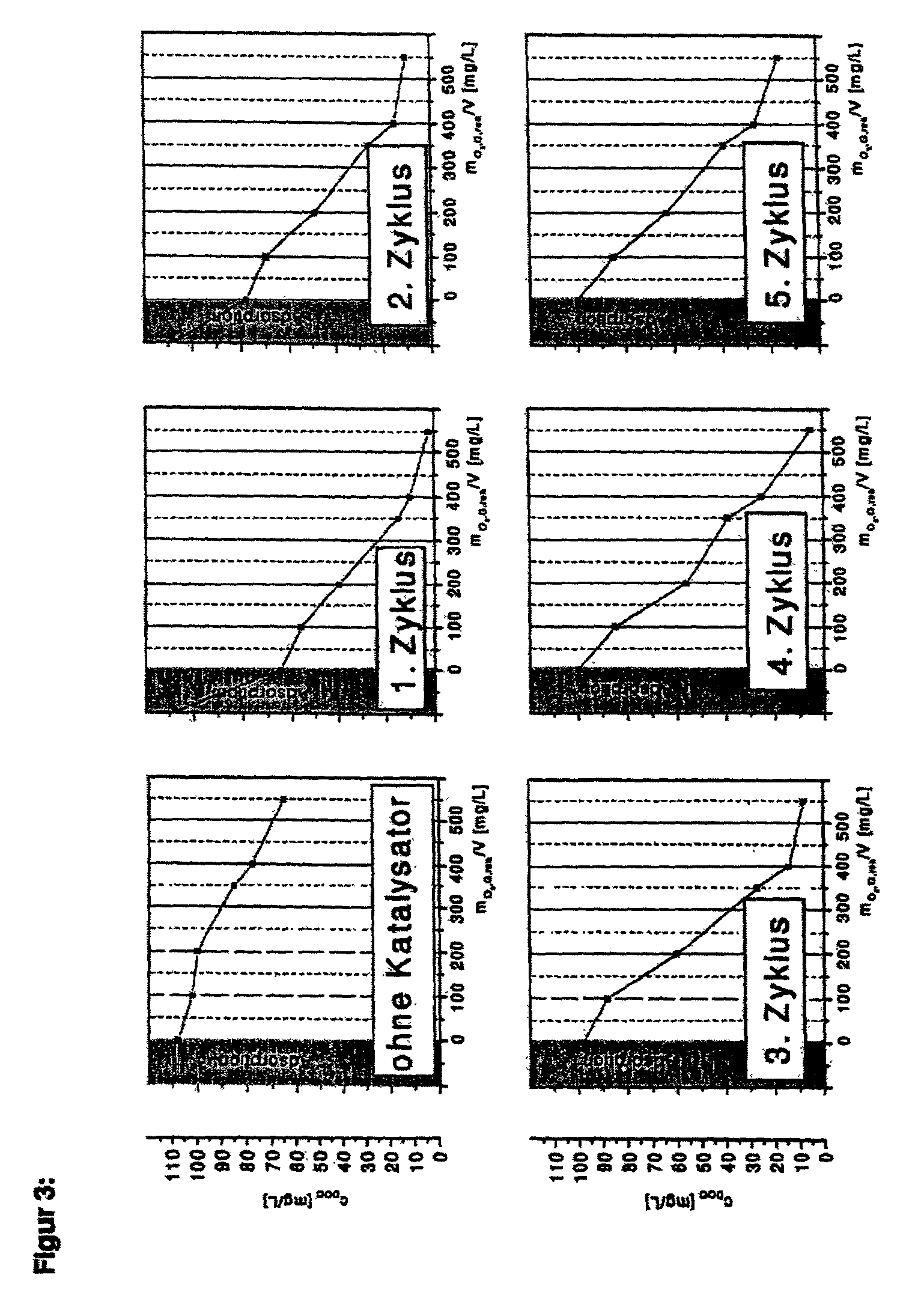Process for the conditioning of polluted water
- Summary
- Abstract
- Description
- Claims
- Application Information
AI Technical Summary
Benefits of technology
Problems solved by technology
Method used
Image
Examples
example 1
[0055] 2.5 L of a model effluent containing 1050 mg / l 2-chlorophenol (equivalent to a COD of 2500 mg / l) were added to a thermostatic suspension reactor and heated to a starting temperature (see below, 30.degree. C. or 60.degree. C.). 2 g / l of a granulated iron(III)hydroxide containing approximately equal quantities of Fe(OH).sub.3 and Fe(O)OH and 50 wt. % free moisture (GEH, Osnabruick) and hydrogen peroxide at a stoichiometry of 1.6 in relation to the initial COD value, were then added. The pH value of the model effluent was set to pH 5 or pH 7. The model effluent was not buffered. The residual COD was analysed after various reaction times.
[0056] At pH 7, virtually complete oxidation of the COD after 24 hours was observed. At pH 5, 70-80% of the COD had already been oxidized within the first 4 hours. During these 4 hours, approximately 10% iron was released.
[0057] The results of Example 1 are represented in FIG. 1.
example 2
[0058] A glass column was filled with approximately 80 g of granulated iron hydroxide according to example 1 (bed volume approx. 76 cm.sup.3) and continuously trickled from above, at room temperature, with a model effluent containing approximately 100 mg / l 3-chlorobenzoate (equivalent to a COD of 320 mg / l). The pH value was not set, the model effluent had a pH of 6-7. Hydrogen peroxide was added in a concentration of approximately 1.0 g / l to the model effluent. Over a period of approximately 1400 bed volume changes, no break-through of the COD was observed. The degree of oxidation over this period was consistently approximately 80%. During treatment, there was only slight elution of iron, substantially in proportion to the quantity of effluent treated.
[0059] The results of Example 2 are represented in FIG. 2.
example 3
[0060] The combined use of ozone and hydrogen peroxide in the presence of a moulded iron(III)hydroxide-iron(III)oxide hydrate catalyst was investigated. For this purpose, 400 mL model effluent was placed in a bubble column with 3-chlorobenzoic acid in a quantity equivalent to a dissolved organic carbon (DOC) of 108 mg / l. 30 g / l catalyst was added and this was fumigated with air for 15 minutes. Then, the dissolved organic carbon (DOC) was determined. It was then ozonized for 15 minutes with 0.67 g O.sub.3 / minute. A 10% solution of hydrogen peroxide was then added to the reactor through a hose pump, in proportion to the ozone mass flow, at a rate of 0.2 g H.sub.2O.sub.2 / minute. The DOC was determined at various times and plotted as a function of the quantity of ozone consumed up to this time. The solution was then poured off and a fresh 3-chlorobenzoate solution was again added to the catalyst recovered. This cycle was repeated four times.
[0061] The results of the 5 cycles according t...
PUM
 Login to View More
Login to View More Abstract
Description
Claims
Application Information
 Login to View More
Login to View More - R&D
- Intellectual Property
- Life Sciences
- Materials
- Tech Scout
- Unparalleled Data Quality
- Higher Quality Content
- 60% Fewer Hallucinations
Browse by: Latest US Patents, China's latest patents, Technical Efficacy Thesaurus, Application Domain, Technology Topic, Popular Technical Reports.
© 2025 PatSnap. All rights reserved.Legal|Privacy policy|Modern Slavery Act Transparency Statement|Sitemap|About US| Contact US: help@patsnap.com



